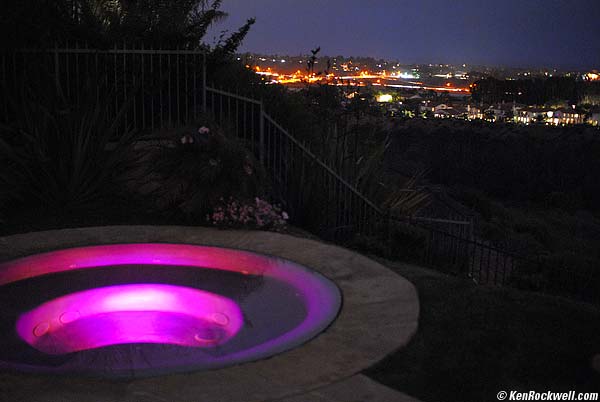Bạn đang xem: 30mm f1
I never read other review before testing lenses, which was true of this lens. I didn"t want any preconceived ideas. Furthermore, I don"t own any Sigma lenses, so I made no presumptions. I didn"t even look at the B&H website to lớn see what the lens retails at; retail price is a good indicator of image quality.
The lens is available for Sony E, Canon EF-M, Leica L, Fujifilm X, và Micro Four Thirds mounts. It is not currently available for Nikon users. I tested the Micro Four Thirds version on my OM-1.
Two lenses arrived in the post from Sigma for me to test. There was this one & the wider 16mm f/1.4 DC doanh nghiệp that I had also agreed khổng lồ put through the mill. I"ll be reviewing that shortly.
At first, the 30mm for Micro Four Thirds cameras struck me as a strange focal length. But, thinking about it, it gives a 39.6° field of view on Micro Four Thirds cameras, thus similar khổng lồ the ubiquitous "Nifty Fifty" lenses on a full frame camera. Mounted on a full frame, on a Sony E mount, the field of view is 50.7°.
So, this should be a good portrait & street photography lens. There are neither OM System (Olympus) nor Panasonic lenses that match the specifications of this. However, with Micro Four Thirds, it will compete with the Olympus 30mm Macro lens, which is slower at f/3.5, the 25mm f/1.8, and the faster 25mm f/1.2 Pro lens. From the Lumix camp, there"s the Summilux 25mm f/1.4 ASPH.
I use only OM System PRO lenses, so I am used to lớn sharper than a scorpion sting results, so I was intrigued khổng lồ know how this lens would perform.
The lenses arrived in recyclable packaging, và the box Sigma had packed them in for postage was reused. That"s a big tick for me.
On unboxing it, I found a sleek-looking, solid, but lightweight lens. Pleasingly, it has a metal mount. The Leica L Mount and Fujifilm X Mount versions are sealed to improve weather tightness, but not with the Micro Four Thirds version I use or the Sony E mount và EOS-M mount versions. The toàn thân is made of what Sigma describes as a Thermally Stable Composite, which it claims exhibits minimal deformation over time. The focusing ring is made from textured rubber.
The lens is supplied with a robust lens hood & lens caps. It takes a 52mm filter that can be used with the hood.
The lens has nine elements in seven groups, two of which are aspherical. Nine rounded aperture diaphragm blades should help give pleasant-looking out-of-focus areas.
Real-World Tests of the Sigma 30mm f/1.4 DC doanh nghiệp Contemporary Lens
I fitted it khổng lồ my OM System OM-1 và took it for a walk to put it through its paces, both during the day and in low light before dawn.
I am a fan hâm mộ of prime lenses; they make you work for the photo. You are forced to lớn position yourself for the best possible image và not rely on tweaking a zoom. 30mm isn"t a focal length I work with, so it took me a while to lớn get used khổng lồ it.
The lens mounted securely khổng lồ my camera with no slackness. The focus ring is large, & the textured rubber feels comfortable. It has just the right amount of resistance lớn stop it from being accidentally nudged. But when I started turning it, it operated smoothly and evenly. I vì chưng much manual focusing và was pleased khổng lồ see that it activated the focus peaking feature on my camera that outlines the edges of the in-focus area.
My first shots were checking for distortion. I found that verticals were nicely upright và horizontals parallel with the top & bottom of the frame, even at the edges — a good start.
With the lens profiles in the development software turned off, there was no obvious vignetting.
Chromatic Aberration Tests
I then shot some high-contrast edges, using the town"s memorial clock tower. Often, with third-party lenses, especially those at the affordable end of the market, there is some sign of purple or green fringing around edges. Even zooming in to lớn 100% and switching off the lens profile in the software, the in-focus edges were clean. However, I did find minimal fringing around the edges of out-of-focus areas.
Even shooting into the sun, the lens flaring was well controlled, and the aperture blades gave a pleasant starburst effect.
A maximum aperture of f/1.4 means that one can achieve, purposefully or accidentally, a narrow field of focus. It also means that very low-light images can be achieved handheld, especially when partnered with the camera"s superior in-body image stabilization. I successfully handheld this lens for two seconds, as seen in the next shot.
Focusing
Autofocus is fast. Occasionally, I found the lens hunting for focus in situations where my Olympus PRO lenses wouldn"t. It has a very close minimum focusing distance of 30 cm.
Out of focus LED Lights shot through a shop window.
The out-of-focus area is creamy and smooth. As I mentioned, it exhibited some chromatic aberrations in the bokeh, but this was not distracting and was fixable in processing.
Lobster pots, f/1.4
Aperture Tests for the Lens
For a lens in this price bracket, it is incredibly sharp. Although there is minimal softening at the extremes, the fine details are there across the range of apertures from f/1.4 to f/16. Even zooming in to 100%, at the smallest aperture, f/16, there was barely any expected softening caused by diffraction; the images would be usable.
The following series of shots are of the same scene. The first is an uncropped version. The following are cropped khổng lồ 1,000 pixels on the long edge.
A herring gull. ISO 200. F/1.4 1/2,000th second. 30mm isn"t intended as a wildlife focal length, but the gull, shot at about 12 yards, proved a good subject. I applied -0.7 EV khổng lồ bring out the detail in the white breast of the bird.
At f/1.4, the detail is sharp. Some aberrations can be seen in the out-of-focus area behind. Click on the image khổng lồ see a full-size version. Heavily cropped khổng lồ 1,000 pixels along the long edge.
At f/2.8, there is a slight increase in sharpness.
f/5.0 was needle0sharp, with the chromatic aberration in the bokeh having all but disappeared.
Again, at f/8.0, the image was sharp. I could perhaps have reduced the exposure a bit further because the sun shining on the gull"s breast resulted in the whites being slightly blown, but that was my error, not the lens".
What I Liked and What Could Be Improved.
I can happily recommend this lens. It"s sharp, the optics are excellent, it"s well made, & the price point is more than reasonable. When mounted on an OM-1, its wide aperture, coupled with the camera"s image stabilization, makes it a great combination. If you are looking for an affordable, well-made, fast prime, this should be on your list for serious consideration.
Will I be buying it? No. Not because it isn"t a superb lens, it is. The main reason is that it is not weather-sealed. Much of my photography happens on sandy beaches with fine sea spray and blowing sand. Or, I might have my camera standing in a stream close lớn the water"s surface. I don"t want dust & moisture lớn ingress into the toàn thân of my otherwise IP53-sealed $2,000 camera. If I were primarily shooting indoors, it would be a different matter.
There"s another reason, too: it"s a fun lens, but I don"t know what I would use it for. I"ve got that focal length covered. Furthermore, I"ve owned prime lenses close in focal length to lớn it và rarely used them. It would be a different story if I were primarily a portrait photographer, và even then, I would be more likely lớn use the Olympus 25mm f/1.2 lens in the studio. However, that costs nearly five times as much, so photographers on a budget will be greatly attracted to the Sigma.
As I said, this would be a good street photography lens, but only if it isn"t raining; I live in England! It"s small & light, weighing between 260 g and 280 g, depending on the version you buy.
It would be perfect for indoor still life. However, sadly, with the OM System cameras, this lens doesn"t allow focus stacking, so one cannot take full advantage of that shallow depth of field as one can with the OM System Olympus Pro Lenses.
That wide aperture is excellent for low-light shooting, & I can see it appealing to some event and nightclub red carpet photographers. Also, although not primarily a video lens, 30mm is an excellent focal length for shooting video, & I can see people buying it for vlogging.
Xem thêm: Top 8 Ống Kính Đa Dụng Cho Nikon Thế Giới Máy Ảnh Số, Ống Kính Nikon Thế Giới Máy Ảnh Số
In short, this is a quality lens, great value for money, and it"s a good buy for someone who needs this focal length. You can purchase it here.
I got this one here. You also can get it here. It helps me keep adding to lớn this site when you get yours from those links, too.
June 2007 More Nikon Lens Tests More Canon Lens Tests.
INTRODUCTION
Top Specs Performance Recommendations


I personally buy from Adorama, Amazon, Ritz, B&H, Calumet and J&R. I can"t vouch for ads below.
The Sigma 30mm f/1.4 is a special-purpose, fast, fixed normal focal length lens for small-format digital SLRs. It sells for about $420.
This Sigma lens works well when used as intended for hand-held shots in dim light. It"s lightweight and works fast & easy, especially with the Nikon D40 & D40x, except that it doesn"t focus very well or accurately.
If you shoot Canon, forget this Sigma và get the superior Canon 28mm f/1.8 EF for less money.
If you shoot Nikon, forget this dumpily-made Sigma và get the newest Nikon 35mm f/1.8 for half the price.
You may consider the rest of this reviews as an historical artifact from the good old first days of digital SLRs.
If you need a full f/1.4 in a normal focal length for a small-format digital camera, can work around some repeatable autofocus inaccuracy & want khổng lồ spend about $400, this is your lens.
It comes in versions to fit Canon, Nikon, 4/3 system (Olympus, Panasonic), Pentax KAF, Samsung, Minolta A AF, Sony A và Sigma cameras. I tried the version for Nikon. I presume the others are optically identical.
This Sigma 30mm f/1.4 lens gives the same angle of view, và somewhat greater depth-of-field at the same aperture, as a 50mm lens does on a film camera.
No other maker makes anything identical lớn a 30mm f/1.4 for under $1,000. If you need f/1.4 in a lens of this focal range for under a thousand dollars, this is it.
If you have a Nikon D40 or D40x, this also is your lens because Nikon makes no lenses faster than f/2.8 which autofocus with a D40/x.
If you"re not using a D40 or D40x, if f/1.8 or f/2 is fast enough in this focal length, or if 50mm (80mm equivalent) is OK, you can pay less và get genuine Canon or Nikon lenses instead. I"ll cover this later at recommendations.
The Sigma 30mm f/1.4 is not a wide-angle and it doesn"t work on film, FX or full-frame cameras. I tried it, và the corners go black on full-frame. It easily covers 1.6x format Canon & Nikons. It might even cover 1.3x Canons lượt thích the 1D series, but I didn"t try it. It"s not rated to work with 1.3x cameras, so good luck.
Good News:
1.) A quality lens that works & handles well. It doesn"t get in the way.
2.) Lightweight.
3.) Fast và easy AF, especially with Nikon D40 và D40x.
4.) Just grab the focus ring, even in AF mode, for instant manual focus override with no need khổng lồ move any switches.
Bad News:
1.) thiết kế flaw causes the manual focus confirmation light in my Nikons not khổng lồ work properly during manual focus override. Furthermore, another defect causes my cameras to ignore my manual focus override in AF-C mode & revert to autofocus. These can be worked around by manually setting my Nikons to lớn manual focus, which eliminates some of the usefulness of instant manual focus override.
2.) AF often focused slightly in front of my subject with my D200, potentially significant at the large apertures for which you buy this lens. I worked around this by pointing my AF sensors at something behind my subject if it was critical. This isn"t a problem for real, live 3d subjects. This effect varies from sample lớn sample and camera khổng lồ camera. It was fine on my D40.
3.). AF didn"t focus beyond about 50" (20m) on my D200. I worked around this by setting focus manually using the accurate infinity mark on the focus scale. It was fine on my D40.
4.) Miscalibrated diaphragm lead lớn overexposed images. I worked around this by setting exposure compensation khổng lồ -0.7 more than what I would use with other lenses.
5.) Single purpose: It doesn"t zoom, & doesn"t focus very close.
6.) Dinky-feeling plastic và rough manual focus feel.
7.) No infinity stop for astronomical use, but infinity mark was accurate.
8.) Optics not up khổng lồ astronomical use, và not as sharp at smaller apertures as other slower lenses.
SPECIFICATIONS with commentary
Top Introduction Performance Recommendations
Name: Sigma calls this the 30mm F1.4 EX DC HSM.
EX: "EXpensive." More expensive than other Sigma lenses.
HSM: "Hyper-Sonic Motor:" Quiet focusing and instant manual focus override. Same idea as Nikon AF-s SWM và Canon EF USM.
DC: "Digitally Crippled." Only works on 1.6x Canon or Nikon digital cameras, not film or 1.3x or full-frame digital. It also comes in mounts for Olympus 4/3 & Sigma cameras.
Focal Length: 30mm. Used on a Nikon digital camera it gives an angle of view similar to what a 46mm lens would give on a 35mm film camera. On a Canon 1.6x camera it gives an angle of view similar khổng lồ what a 49mm lens would give on a 35mm film camera. See also Crop Factor.
Maximum Aperture: f/1.4
Optics: 7 elements, 7 groups, including one SLD and one ELD glass element (same idea as Nikon"s ED or Canon"s UD) and one molded glass aspherical element. This magic glass is supposed lớn help reduce màu sắc fringing, while the aspherical element ought to help reduce coma and spherical aberration at f/1.4. In practice this Sigma has more màu sắc fringing và is fuzzier in the corners than my Nikon 18-200mm zoom, oh well.
Diaphragm: 8 blade octagonal, stopping down to lớn f/16.
Filter Size: 62 mm.
Close Focus: 1.25" or 0.40 m from the image plane (the back of the camera), rated. This isn"t very close. All the similar Canon và Nikon lenses focus much closer. I see no mention of close-range correction or floating elements, which is most likely why it only focuses as close as a foot và a half.
Maximum Reproduction Ratio: 1:10.4, not very close.
Infrared Focus Index? No, unfortunately.
Size: 3.0" diameter x 2.3" extension from flange (76.6 x 59mm), rated.
Weight: 14.345oz. (406.7 g), measured, naked.
Hood: included.
Case: nice padded Cordura-style case included.
PERFORMANCE
Top Introduction Specs
Recommendations
Autofocus
Bokeh
Color
Color Fringes
Construction
Distortion Ergonomics
Exposure
Falloff Film Filters
Flare Macro
Serial Number
Sharpness
Sunstars
OVERALL
It works well for its intended purpose: low-light hand-held shooting. Optically it"s not as good for shooting demo charts as the Canon or Nikon f/1.4 lenses that cost several times as much, but this is irrelevant because of the tiny depth of field at f/1.4 for photographing real things.
FOCUSINGback lớn Performance or back to lớn Introduction.
Focusing works great, one of the advantages of the Sigma 30mm f/1.4. Unlike my Nikon 28mm f/1.4, just grab the focus ring at any time for manual focus, no switches required. Unlike the Sigma 10-22mm which didn"t always focus well with other than the central AF sensor of my D200, this 30mm f/1.4 focuses fine with all my AF sensors.
Autofocus Accuracy
AF accuracy is fine for the things I would shoot with this lens, like people và kids in dim light.
The Sigma 30mm f/1.4 is very bad, depending on your camera, for photographing at long distances. The AF system, at least on my D200 at f/1.4 and large apertures, consistently wouldn"t focus at infinity and instead focused too closely. I focused by scale instead for objects further away than about 50 feet (20m). If this is a lot of what you do, you probably won"t be happy with this lens. It was perfect with my D40. This will vary from sample lớn sample và camera to camera.
AF accuracy is always a problem for shooting chạy thử charts with f/1.4 lenses. This has driven me crazy since the 1970s. For hand-held shots in dim light of wiggly subjects (the whole point of this lens) the AF accuracy is fine. For shooting flat demo charts it"s poor, but no one buys this lens for shooting kiểm tra charts. For demo charts and astronomical use, get the discontinued Nikon 28mm f/1.4 AF or the insanely good new Canon 85mm f/1.2L II.
At f/1.4 this is obvious if you"re dumb enough to be shooting at f/1.4 in daylight. In real use it"s invisible at f/4, & in the dark it"s not much of an issue since most things worth shooting are deeper than the depth of field anyway. If you worry about these issues, don"t get this lens, or at least try a different sample.

Ryan on his changing table. (D40, Sigma 30mm, f/1.4 at 1/30, auto ISO chose ISO 1,600, cropped lớn about 1/2 of the image.)
This shot is typical: focus is fine for the real things where one needs f/1.4 in dim light. Notice how his hand is completely out of focus due to no depth of field. This sort of shot is why you get this lens, & for this stuff, this lens is great. In the full size image (not shown) his face, eyes & texture of the fabric in his shirt look great. Remember, this kid never holds still, so you can"t focus manually on him or use a slower lens in the light I had.
Here are more practical examples. In each case, focus is fine.

Palm Tree. (D200, Sigma 30mm, f/1.4 at 1/8 hand-held, tự động ISO chose ISO 1,600, full image.)

Spa on the Moon. (D200, Sigma 30mm, f/1.4 at 1/2 second hand-held, tự động ISO chose ISO 1,600, full image. Autofocused at close to infinity; spa làm đẹp is out of focus.)
What Moves When Focusing
The optical tube inside the mount moves in and out. The filter ring and the externals of the lens don"t move.
Focus Distance Scale
Meters và feet, crammed together và the same color. Good luck figuring out which is which.
Depth of Field Scale
NONE, too bad since it would make sense on a fixed focal length lens.
Speed
AF tốc độ is fast. This is rarely an issue for short focal length lenses.
Ease of Manual Focusing
Excellent: just grab the focus ring at any time for instant manual focus override. You don"t need to lớn move any switches.
Like other Sigma lenses, it feels gritty và cheap. It doesn"t have the smooth, precise feel of a Canon or Nikon lens.
Unlike a real Nikon lens, Sigma is a third-party unauthorized (by Nikon) attachment. You always run the risk of having some advanced features not work. Nikon does not chia sẻ its proprietary operating information with anyone, so third các buổi party lenses may và may not work correctly. This is even worse as you buy newer cameras, because Nikon lenses today already incorporate compatibility with Nikon cameras of tomorrow about which Nikon is telling no one. Did you notice recently how all Nikon"s new lenses for the past few years have been AFS, so that they work on the D40 introduced only in December 2006, effectively skunking Tokina who make no lenses which will autofocus on the D40?
The problem I discovered with the Sigma 30mm f/1.4 is that my Nikons" focus confirmation lights, critical for manual focusing, don"t work properly unless you deliberately put the camera into the manual focus mode. This negates much of the magic of having instant manual focus override, since you may not have enough precision using only the ground glass to lớn focus at f/1.4. (The ground glass only shows the view at about f/2.8, not at f/1.4.)
Nikon lenses work correctly, which means that any time you grab the manual focus ring with the shutter pressed halfway, even with the camera left in autofocus mode, the focus confirmation light works properly. With this Sigma lens, the light locks up in either on or off, wherever it was when you grabbed the ring.
Creepier, after you"ve grabbed the manual focus ring in AF-C (continuous) mode, the Sigma will revert to AF mode instead of locking the manual focus properly.
Correct operation, which is what you get with real Nikon lenses, is that even if you"re in AF-C mode & grab the manual focus ring that the focus stays set where you put it until you release and retap the shutter buton halfway.
This gets worse on my D40, since my D40 has no external AF/MF switch. On the D40 I need khổng lồ go into a menu khổng lồ select manual focus, and to select between single (S) or continuous (C) or automatic selection (AF-A) AF modes. Therefore, when I grab the manual focus ring on my D40 in the D40"s default AF-A mode, if the subject is not moving I can set focus manually (still without a focus confirmation light) on the Sigma 30mm f/1.4. Heaven help me if the D40 thinks the subject is in motion, because the D40 will automatically be tracking the subject. Now if I grab the Sigma"s manual focus ring, I"ll get manual focus for a moment, and then the D40 will take over again & continue to autofocus.
These issues are subtle, but potentially disturbing. You may not notice them until after you"ve owned the Sigma for a while, and I can imagine people sending things back wanting these issues repaired. Fat chance; these sorts of annoying missed details are why I prefer not to use anything other than a lens of the same brand as my camera.
Focus Breathing
Breathing is a motion picture term which refers lớn what happens as you pull (change) focus from near to far. I menu this for people putting these lenses on their Canon XL-1s for shooting video.
It has a little bit of the usual focus breathing to be expected for a lens which focuses by the traditional racking in và out.BOKEH back to lớn Performance or back khổng lồ Introduction.
Bokeh is nice! Out-of-focus backgrounds get soft và don"t distract.
Typical for lenses with aspherical elements, out of focus points of light in the corners can acquire bizarre shapes. The Sigma 30mm f/1.4 usually renders points of light behind the subject in the far corners as a cross between a U and a V. This isn"t that important.
The bokeh of the Sigma 30mm f/1.4 is a nice, natural softness. I lượt thích it.
COLOR FRINGES (Lateral Chromatic Aberration or LCA)
back to Performance or back khổng lồ Introduction.
The Sigma 30mm f/1.4 is ordinary. It"s about the same as the exotic Nikon 28mm f/1.4 AF, but not as good as today"s Nikon 18-200mm VR. All of these are better than the 1980-vintage Nikon 28mm f/3.5 AI manual focus lens I threw in for fun, but then again, I only paid $35 for the old AI lens in perfect condition.









